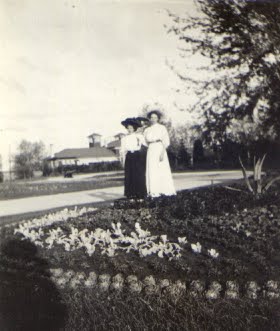

At the end of the 19th century, any city that wanted to be taken seriously as a cosmopolitan destination needed to include lavish gardens within their border. It is this prerequisite that prompted the fledgling city of Denver to set aside 1,280 acres for formal gardens in 1878. Their decision was reinforced after the 1893 World’s Fair kicked off the City Beautiful movement.
City Park was the first, and largest, of these parks to come to fruition. Just a mile east of the center of Denver, the park was platted by Reinhard Schuetze, Denver’s resident landscape architect. The land was essentially barren at the time of the park’s founding. Other than a few willows along the City Ditch, the area was a vast expanse of cactus and prairie grass. In an attempt to shade the public, Denver schoolchildren began to plant trees on the first Arbor Day in 1884.
In addition to shade trees, Scheutze also planned walking paths, ponds, and flowerbeds for the Victorian public to enjoy on any given Sunday afternoon.

Two ladies stroll City Park in 1908. Note the Pavilion in the background. |
As the new European-style park grew in popularity, the amenities it offered grew as well. The installment of the Gentlemen’s Driving and Riding Club included a horse racing track, stables and a grandstand. The racetrack was later used by automobiles and was not dismantled until 1950.
Ferril Lake was in place by 1897 and helped to transform the dry landscape. Now with proper irrigation, the plantings would stand a better chance of surviving the harsh summer sun. The lake also attracted new birds and waterfowl to the area. The Pavilion was constructed in 1896 and has served as a dance hall and event center. Boats are also available for rent at the Pavilion, including those shaped as swans.
A grand fountain was placed in Ferril Lake at the insistence of then governor Speer, as Denver hosted the Democratic National Convention of 1908. It entranced those in attendance with a dazzling light display. Though it fell into disrepair and had not captivated audiences in over 30 years, it was brought back to life for the 2008 Democratic National Convention, again held in Denver.
The Denver Zoo was originally a fairly unsecured animal viewing site. It came into existence out of necessity in 1896, when then governor McMurry was given a bear cub as a gift. The young black bear soon became unruly, and was given to the City Park manager. In 1906, Governor Speer felt that the unruly menagerie calling the park home needed to be reined in, but not in the traditional way. Rather than cages and bars, he felt that a more natural habitat would enhance the zoo. “Bear Mountain”, designed by the first zoo director Victor Borcherdt, opened in 1918. This natural exhibit was the first of its kind and revolutionized zoo enclosures. In addition to Bear Mountain, were deer and elk corrals, free-ranging pheasants, and a monkey habitat.
The streets bordering City Park were popular building sites for mansions in the early 1900’s. As the city grew and the need for elbowroom became apparent, the land surrounding City Park became a thriving suburb. The diversity of the architecture reflects the influx of new residents to the area. In any single block you may see Queen Anne Victorians, Georgian mansions, or quaint bungalows.
As the streetcar lines stretched further to include the park and surrounding areas, the neighborhoods began to grow in earnest. East High School was relocated to the park’s southeast boundary in 1925, cementing its future in Denver’s history
Today, the area is experiencing an upsurge in popularity. The park is a logical place to host any number of charity events, marathons and festivals. The Denver Zoo and Museum of Nature and Science are at the forefront of Denver’s cultural offerings.
If you would like any further information on City Park or any other Denver real estate, please contact VintSources:
Snow, Shawn. Denver’s City Park and Whittier Neighborhoods. Chicago: Arcadia Publishing. 2009
age Homes of Denver.
Copyright © 2013 Vintage Homes of Denver
Real Estate Website Design by High Elevation